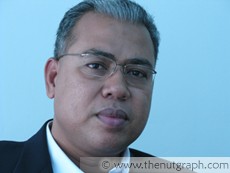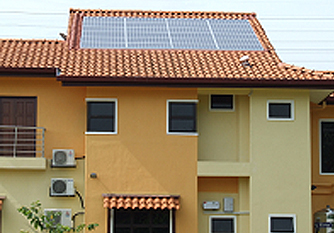
Solar vs nuclear: Giving solar a chance.
WHEN the government announced plans for a 1,000MW nuclear plant, solar power is often dismissed as too costly to implement on a large scale. However, developments in the photovoltaic (PV) industry suggest that with planning, it’s not necessarily prohibitive.
For certain, solar power alone cannot displace fossil fuels as an energy source. But it is possible for a mix of solar and other renewable energy sources like biomass, biogas and hydropower to replace fossil fuels, says Ahmad Hadri Haris. He is the national project leader of the Malaysia Building Integrated Photovoltaic project, and a renewable energy technical adviser to the Malaysian government.
The question for Malaysia is whether it can increase its use of PV and other renewable energy sources before turning to contentious energy sources like nuclear. Can funds and PV technology be made available for Malaysia to explore and harness solar power? If yes, does the government have the political will to give solar a chance?
Solar potential
 Shamsudin
Shamsudin
According to Malaysian Photovoltaic Industry Association president Shamsudin Khalid, the cost of PV cells has dropped 40% in the last 10 years. Indeed, the PV industry is growing, and Malaysia is currently the world’s fourth largest PV modules producer. Shamsudin says Malaysia exported 784MW or RM1 billion worth of PV modules in 2009.
Despite such advancements, there isn’t much of a domestic PV market. Currently, only 1MW of electricity is solar-derived, mainly by participants of the Suria 1000 pilot programme. It’s a mere fraction of the total 1% or 30MW of electricity currently generated from renewable energy sources. This is far short of the 9t Malaysia Plan’s target for renewable energy sources to contribute 350MW to total energy supply by 2010. Under the 10th Malaysia Plan (10MP) from 2011 to 2015, the government wants 5.5% of total electricity to come from renewable energy sources.
But what is the government doing to ensure these targets are met?
In 2009, the Malaysian Photovoltaic Industry Association submitted to the Energy, Green Technology and Water Ministry a five-year plan to increase PV contribution to national energy at 2,600MW per annum. This well exceeds the unmet 2010 target for renewable energy sources to contribute 350MW to total energy supply.
The plan involves installing PV panels on the rooftops of homes, and commercial, industrial and even government buildings. Electricity generated by the PV cells would immediately be fed to the national grid. At the same time, electricity is drawn from the grid for consumption. Through the Feed-in Tariff (FiT) mechanism, home or building owners can sell their green electricity to the grid at a higher price than the electricity they buy, as incentive for using the technology.
“It’s passive income for home and building owners. In countries where FiT is implemented at a preferential rate for green energy producers, the cost of PV installation is recoverable in 10 years,” Shamsudin tells The Nut Graph in an interview in Shah Alam.
PV cells have a warranty of up to 25 years, he adds.
There is potential to generate more electricity using rooftop-mounted PV panels as there are about five million houses nationwide, according to Shamsudin. This doesn’t include commercial and industrial roof space.

The Malaysia Building Integrated Photovoltaic project, meanwhile, is in talks with independent power producers about using PV to complement gas fuel. This combination is already used by US power utilities. “It’s a viable proposition because PV is getting cheaper and is bankable. But only provided gas subsidies for power generation are gradually removed,” Ahmad Hadri says in a phone interview.
Financing
The Malaysian Photovoltaic Industry Association’s five-year plan to produce 2,600MW per year from rooftop PV systems would require an estimated RM5.6 billion on credit through various sources. This would include the FiT scheme and commercial lending, says Shamsudin. A small 3kW rooftop system would cost around RM60,000 to buy and install, he says.
“From [the association]’s talks with the banking industry, there are indications that development and commercial banks are willing to do so, as it is already practised in other countries,” notes Shamsudin.
Energy specialist Asfaazam Kasbani says bank lending for home PV systems is already available for newer housing projects, such as in certain developments in Putrajaya and Shah Alam. Consumers, however, are still wary of the high capital cost.
But in principle, FiT contracts are reliable and bankable, says Asfaazam, who is assistant resident representative of the United Nations Development Programme Malaysia.
The guaranteed funding is drawn from increased electricity tariffs. In other words, the higher price at which a power provider were to buy electricity from green energy producers will be funded through tariff hikes. This makes FiT, developed about 10 years ago in Germany, the most popular of funding mechanisms for green energy because it involves consumer and private sector funding.
 Asfaazam. Pic courtesy of Asfaazam Kasbani.
Asfaazam. Pic courtesy of Asfaazam Kasbani.
“FiT quickens the move towards grid parity, whereby the cost of renewable energy-generated electricity will be equivalent to or cheaper than fossil fuel,” Asfaazam says in a phone interview.
The government plans to introduce FiT in 2011 under the Renewable Energy Bill to be tabled in Parliament by the end of 2010. The recently unveiled 10MP also includes the “introduction of the FiT of 1% to be incorporated into the electricity tariffs of consumers to support the development of [renewable energy]”.
What this means is that a gradual increase in electricity rates amounting to 1% over the next five years will fund renewable energy-related activities. This includes Tenaga Nasional Bhd’s purchase of green energy from solar and other sources, Asfaazam explains.
Though consumers may balk at paying more for electricity, Shamsudin says introducing FiT will be good for the overall economy because of job creation and export growth.
“FiT will create a domestic PV market. A local market can drive expansion of other solar component sectors and markets, like the building of larger-scale PV power plants that can help Malaysia achieve a higher output of green energy in a shorter time. We can meet our renewable energy goals faster,” Shamsudin says.
Comparing options
The problem with solar, as with other renewable energy sources, is its low output at high cost compared to fossil fuels. Asfaazam’s estimate of a ringgit-for-output comparison is roughly RM25,000 worth of PV systems for every 1kW capacity. That’s just about enough to power one air-conditioner and four lights. Nuclear is the only alternative that can match the output of fossil fuel or mega hydroelectric projects.
According to Ahmad Hadri, five times the capacity of solar power is required to generate an equivalent amount of energy from nuclear power. Further, a nuclear plant when up and running can generate electricity almost continuously, whereas solar technology is most efficient only during peak daylight hours.
Neither nuclear nor solar is cheap, but Ahmad Hadri says solar has environmental and financing benefits over nuclear in the long run as the price of PV gets cheaper over time.
“In parts of Europe and the US where PV usage has gone commercial and where there is no petrol subsidy, the price of PV will be on par with fossil fuel in the next few years,” he says.
Whereas for nuclear, commercial lending is unavailable, and continued high spending is required for maintenance and uranium imports.
 Ahmad Hadri (Source: mbipv.net.my)
Ahmad Hadri (Source: mbipv.net.my)
“Malaysia’s long-term goal in energy planning should not just be about energy security but energy independence, where we won’t have to rely on imported fuel sources,” notes Ahmad Hadri.
Environmentally, too, nuclear power is not totally carbon-free as claimed by its proponents, he adds. “It is carbon-free during plant operations, but people forget that emissions are released during the mining and enrichment process of uranium, and in the process of de-commissioning the waste,” he says.
Democratising energy
For Malaysia to maximise its renewable energy potential, electricity tariffs will have to reflect the true cost of production and supply. Fossil fuel subsidies will have to be gradually cut. Consumer habits will have to change by reducing consumption and using energy-efficient appliances.
It sounds like a burden to the public, but Ahmad Hadri says FiT, while providing consumers passive income, is better in the long run by distributing the cost of power production, as well as income among the public. Everyone can generate their own power and contribute to national supply. Whereas building a single nuclear or fossil fuel power plant would concentrate costs and spending in the hands of the state and select contractors.
These issues are some of the things the government must address transparently. Already, Prime Minister Datuk Seri Najib Razak has promised a comprehensive study on the government’s proposed nuclear plant. From what the experts are saying, that comprehensive study must clearly include giving solar a chance.
-endev malaysia